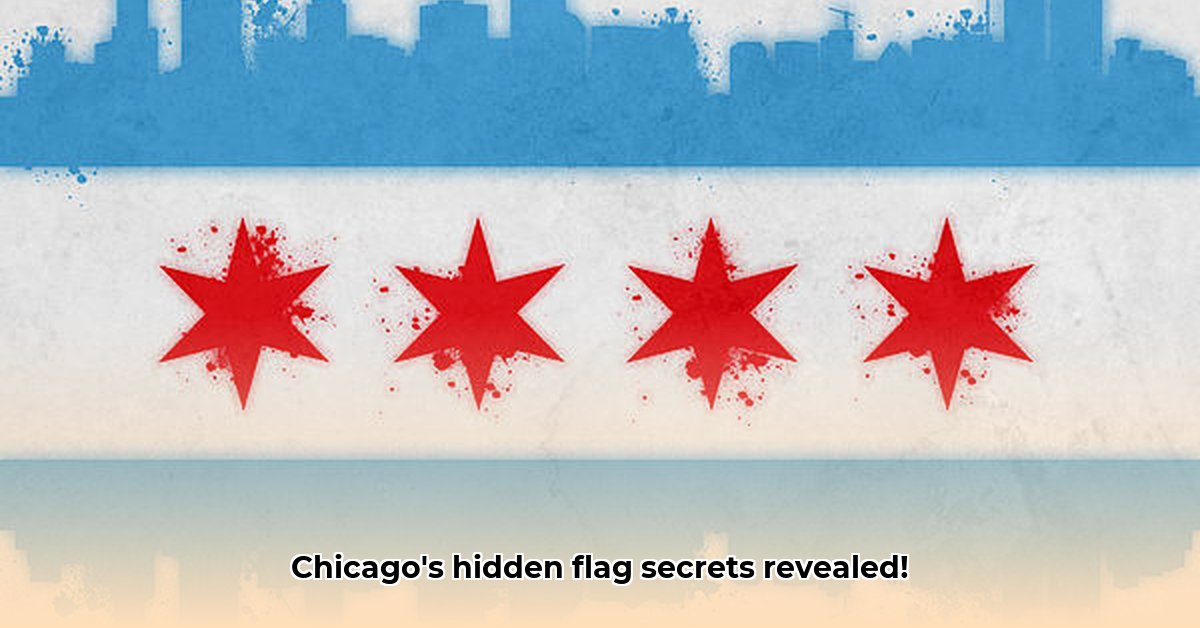Ever wondered about that cool flag you see all over Chicago? It’s more than just pretty colors and stars – it’s a storybook of the city’s history and spirit! We’ll unravel the mystery behind its unique design, exploring what those colors and stars really mean and how they connect to Chicago’s past. We’ll even show you exactly what makes it so special. Get ready to discover the hidden meanings and lasting impact of this iconic symbol, and learn why it’s still important to Chicagoans today – it’s a piece of the city’s soul! For more on flags and their symbolism, check out this [Latin flag resource](https://www.lolaapp.com/latin-flag/).
The Chicago Flag: Unveiling History and Civic Pride
The Chicago flag. You see it everywhere – on hats, T-shirts, maybe even your neighbor’s porch. But have you ever stopped to think about what it really means? It’s more than just a pretty design; it’s a visual story of Chicago’s incredible journey, a story woven into the very fabric of the city’s identity and urban symbolism.
A Symbol of Resilience: Tracing the Flag’s Origins
Picture this: Chicago, 1917. The city was still recovering from the Great Chicago Fire, a devastating event that nearly leveled the city. But amid the rebuilding, there was a surge of optimism, a feeling that Chicago was ready to rise again. This spirit of renewal needed a symbol, a visual representation to rally the city’s residents. Enter Wallace Rice, a poet, lecturer, and designer who answered the call after Mayor William Hale Thompson appointed a municipal flag commission in 1915. Rice spearheaded a city-wide design competition. His design was picked—and what a design it was! It wasn’t just about aesthetics; it was about telling a story; a narrative rooted in Chicago’s cultural heritage, that would resonate with Chicagoans for generations. The flag was officially adopted by the City Council in 1917.
Decoding the Design: Interpreting Stripes and Stars
The Chicago flag is deceptively simple. Two bold blue horizontal stripes represent Chicago’s lifelines: Lake Michigan and the Chicago River. The top stripe symbolizes Lake Michigan and the North Branch of the Chicago River, while the bottom represents the South Branch of the river and the “Great Canal,” referencing the Chicago Portage. These waterways have shaped the city’s development, its economy, and its very character. They provide a sense of both beauty and practicality. Sandwiched between the blues are three white stripes, representing the city’s three main sections: the North, South, and West Sides. Each stripe represents a part of the city’s rich diversity and cultural tapestry.
But the real intrigue lies in those four bright red, six-pointed stars. Rice cleverly avoided using five-pointed stars, which could’ve been reminiscent of the American flag. These stars represent pivotal milestones in Chicago’s history:
| Star Number | Event Represented | Significance |
|---|---|---|
| 1 | Fort Dearborn (early Chicago settlement) | Chicago’s humble beginnings and its connection to early American history |
| 2 | The Great Chicago Fire of 1871 | A devastating event that ultimately shaped Chicago’s grit, resilience, and innovation |
| 3 | The World’s Columbian Exposition (1893) | Chicago’s emergence as a global city and its architectural excellence |
| 4 | The Century of Progress Exposition (1933-34) | Chicago’s ongoing commitment to progress, innovation, and world-leading technology |
These events are not just historical facts; they’re integral to Chicago’s DNA. Each star represents a moment of transformation, a testament to the city’s remarkable ability to overcome adversity and forge ahead. Is it any wonder this flag is a constant source of local pride? The six points of each star also carry symbolic weight. For example, the star representing the Great Chicago Fire signifies transportation, labor, commerce, finance, populousness, and health.
Beyond the Fabric: Chicago’s Shared Identity
Today, the Chicago flag is much more than just a piece of cloth; it’s a symbol of immense civic pride. You’ll find it everywhere – on clothing, merchandise, buildings, and even vehicles. It’s a powerful reminder of Chicago’s shared history and collective identity, connecting residents from all walks of life. It’s a symbol of unity and resilience, both past and present. It is, in a way, the visual embodiment of the Chicago spirit. The pervasiveness of the flag speaks volumes about the city’s strong sense of community. Its popularity even landed the flag in second place in a 2004 North American Vexillological Association review of 150 American city flags.
Legal Protections: Ensuring the Flag’s Integrity
While the official city code protects the Chicago flag’s design from unauthorized use, enforcing this is often difficult. The Municipal Code of Chicago prohibits using the flag for anything other than decoration or display and bans adding any unauthorized letters, words, or devices to it. Its popularity and widespread use often surpass any legal constraints. This widespread (and largely unregulated) use speaks volumes about the powerful connection that Chicagoans have with their iconic flag and the intrinsic value of civic iconography. The flag’s ubiquity highlights its profound cultural impact.
A Dynamic Emblem: The Flag’s Future Potential
Interestingly, even though there have been suggestions to add more stars, representing additional significant events in the city’s history, the flag remains largely unchanged. Potential events for a fifth star include the opening of the first public school in Chicago in 1835, the reversing of the Chicago River in 1900, and honoring the city’s first Black mayor, Harold Washington. The current design is seen by many as a perfect encapsulation of the city’s founding, its challenges, and its ultimate triumph. This design stands as a testament to the enduring power of its original design and its continuing cultural significance in the city. The flag’s success lies in its ability to connect people to a collective identity and collective purpose.
The Chicago flag isn’t just a static symbol; it’s a living, breathing representation of a city that continues to evolve. It’s a captivating narrative that unites Chicagoans, reminding them of their shared past and inspiring their vision for the future. How does this potent symbol continue to shape the city’s narrative?
Examining the Chicago Flag Design Evolution
The Chicago flag, a seemingly simple design, tells a fascinating story of the city’s evolution. Its current form, a vibrant tapestry of white and blue stripes punctuated by four red stars, wasn’t always so. Let’s explore how did the chicago flag design evolve over time.
The Starry Ascent: From Two to Four Points of Pride
The flag’s design debuted in 1917 by Wallace Rice. The initial version featured just two six-pointed red stars, meticulously chosen to avoid the five-pointed style prevalent on national flags. These stars represented the Great Chicago Fire of 1871 and the World’s Columbian Exposition of 1893. The North, West, and South Sides of the city, represented by the white stripes, and the two blue stripes symbolizing the Chicago River and Lake Michigan. But Chicago, a city of rapid expansion, wasn’t static.
In 1933, a third star was added to commemorate the Century of Progress International Exposition (1933–34) and reflected its growing influence. The six points signified Chicago’s status as the United States’ second-largest city at the time, its Latin motto Urbs in Horto (“City in a garden”), its “I Will” motto, the Great Central Marketplace, Wonder City, and Convention City. Again, this addition marked a pivotal moment in Chicago’s history – reflecting its rising profile on the national stage. This star served as a testament to Chicago’s ambition and influence. What events will shape the flag in the future?
Then, in 1939, a fourth star joined the constellation. This star commemorated Fort Dearborn, and its six points represent the political entities the Chicago region has belonged to and the flags that have flown over the area: France, 1693; Great Britain, 1763; Virginia, 1778; the Northwest Territory, 1789; Indiana Territory, 1802; and Illinois (territory, 1809, and state, since 1818). The newest addition symbolized the city’s growing importance in the nation. Again, this addition marked a pivotal moment in Chicago’s history – reflecting its rising profile on the national stage. This star served as a testament to Chicago’s ambition and influence.
Distinguishing Design: The Six-Pointed Star Rationale
Why six points? Rice deliberately avoided the five-pointed star, a common feature on national flags. He sought to establish a unique identity for Chicago, a symbol distinct from any nation. The points also distinguished the stars from the Star of David, ensuring the flag’s symbolism remained secular and focused on the city’s history. This conscious choice speaks volumes about the city’s desire for self-representation. It’s a small detail with a powerful impact. The flag ranks high in design quality, rated by the North American Vexillological Association.
Each point of the star, while not explicitly defined in all instances, is often interpreted to represent a key aspect of
















